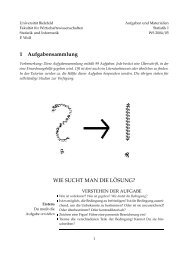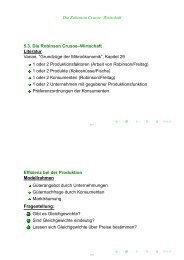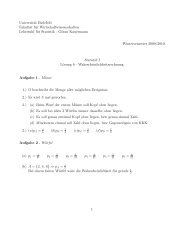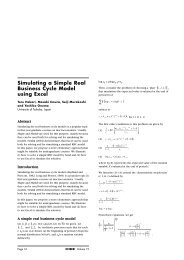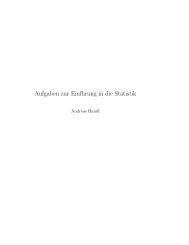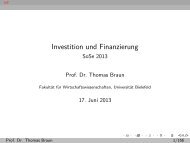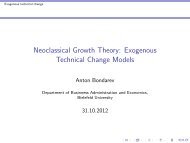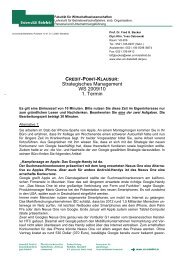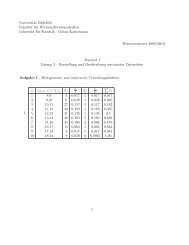Taste for variety: Model of Grossman and Helpman.
Taste for variety: Model of Grossman and Helpman.
Taste for variety: Model of Grossman and Helpman.
You also want an ePaper? Increase the reach of your titles
YUMPU automatically turns print PDFs into web optimized ePapers that Google loves.
Variety expansionIntroduction◮ In the end <strong>of</strong> 1980-s economists mainly agreed upon theunsatisfactory results <strong>of</strong> neoclassical growth theory;◮ According to empirical findings,less than 50 percent <strong>of</strong> growthmight be attributed to the growing capital - labour ratio;◮ Hence, the half <strong>of</strong> growth rate is due to Solow residual;◮ Thus the models endogenizing technology as a source <strong>of</strong>growth emerged;◮ The first generation <strong>of</strong> such models were <strong>of</strong> taste-<strong>for</strong>-<strong>variety</strong>type;◮ The main idea <strong>of</strong> these was to find some source <strong>of</strong> growth,other that capital productivity (K/L ratio);◮ The model <strong>of</strong> <strong>Grossman</strong> <strong>and</strong> <strong>Helpman</strong> achieved nice <strong>for</strong>maldescription <strong>of</strong> these ideas in 1990.
Variety expansionThe <strong>Model</strong>Overall structure◮ There are two countries in the world economy;◮ Each country is engaged in three types <strong>of</strong> productiveactivities:◮ Final output, being consumption good, Y ;◮ The continuum <strong>of</strong> varieties <strong>of</strong> differentiated middle products(intermediaries);◮ Research <strong>and</strong> development (R&D).◮ There is a single primary factor <strong>of</strong> production;◮ This factor is fixed, constant, specific to the country i:L i = const.◮ Capital consists <strong>of</strong> all the intermediaries, as in Romer’s model.
Variety expansionThe <strong>Model</strong>Final goods producers◮ The final good is produced in a perfectly competitive way;◮ Hence the prices are set through the marginal pricing rule,P = MC;◮ Each such producer solves the problem <strong>of</strong> pr<strong>of</strong>it maximization:( ( ∫ nΠ i (Y i ) = p Yi BA i L 1−β∫ n− w i L Yi −0Y i0p xi (ω)x i (ω)dω →) β/α )x i (ω) α dω −max . (2)L Yi ,x i (ω)
Variety expansionThe <strong>Model</strong>Middle product dem<strong>and</strong> IIFrom Eq. 4 we derive dem<strong>and</strong> <strong>for</strong> the middle products ω = k,ω = l:( ∫x i (k) = p xi (k) − 11−α ×(βp nYi BA i L 1−βx i (l) = p xi (l) − 11−α ×(βp Yi BA i L 1−βY iY i0( ∫ n0) β/α−1 ) 1x i (ω) α 1−αdω; (5)) β/α−1 ) 1x i (ω) α 1−αdωDenoting the term in brackets as X one may rewrite dem<strong>and</strong> asx i (k) =(6)( pxi (l)) 11−αx i (l). (7)p xi (k)
Variety expansionThe <strong>Model</strong>Middle product dem<strong>and</strong> IIINow insert this last equation into the expression <strong>for</strong> the output:X =(( n∫ ) β/α )βp Yi BA i L 1−β1Y ix i (ω) α 1−αdω0( n∫ ) 1x i (ω) α 1−αdω0(8)This using Eq. 7 will give the dem<strong>and</strong> <strong>for</strong> each intermediateproduct as function <strong>of</strong> total output, X <strong>and</strong> prices:x i (k) = X ×n∫0p xi (k) − 11−αp xi (ω) 1− 11−α dω(9)
Variety expansionThe <strong>Model</strong>Final output price◮ Using Eqs. 3, 4 we obtain the price <strong>of</strong> the output as afunction <strong>of</strong> factor prices <strong>and</strong> productivity:p Yi =( wi) 1−β ( ∫ nA i0p X (ω) 1−ɛ dω) β/(1−ɛ);(10)ɛ = 11 − α > 1.◮ Middle products are freely traded between both countries <strong>and</strong>have the same price in both countries,p xi = p xj = p X . (11)
Variety expansionThe <strong>Model</strong>Middle products producers◮ Middle products producers engage in oligopolistic competitionin every country;◮ Every producer sets the price <strong>of</strong> his/her product as tomaximize pr<strong>of</strong>its:π i (ω) = (p X (ω) − w i a LXi ) ×p X (ω) −ɛβ ∑ n∫p X (ω) 1−ɛ dω i0p Yi Y i . (12)where a LXi is the unit labour requirement in country i <strong>for</strong>production <strong>of</strong> intermediaries.◮ The pr<strong>of</strong>it is per unit pr<strong>of</strong>it (in brackets) times the dem<strong>and</strong> <strong>for</strong>the middle product.
Variety expansionThe <strong>Model</strong>Prices <strong>for</strong> middle products◮ The price is set according to the fixed mark-up rule:αp X (ω) = w i a LXi ; (13)◮ From this it is straight<strong>for</strong>ward that all the varieties fromcountry i has the same price, p Xi ;◮ With equal prices <strong>for</strong> all the nation-specific varieties, theequation <strong>for</strong> final good’s price, Eq. 10, is condensed intop Yi =( wiA i) 1−β (∑◮ And <strong>variety</strong> price in country i isjn j p 1−ɛX j) β/(1−ɛ)(14)p Xi = 1 α w ia LXi . (15)
Variety expansionThe <strong>Model</strong>Output <strong>of</strong> intermediaries◮ With prices given by two last equations, the aggregate output<strong>of</strong> middle products is:X i =∑jn ip −ɛX in j p 1−ɛ β ∑X j jp Yj Y j (16)◮ Being the function <strong>of</strong>:◮ Number <strong>of</strong> producers in the country, n i ;◮ Price <strong>of</strong> the <strong>variety</strong> (identical across varieties), p Xi ;◮ Total output <strong>of</strong> final product in both countries.
Variety expansionThe <strong>Model</strong>Comments◮ So far the model follows that <strong>of</strong> Romer (1990) very closely;◮ The role <strong>of</strong> fixed human capital is delegated to labour with nosignificant differences;◮ There is no difference in levels <strong>of</strong> production <strong>of</strong> differentvarieties;◮ This is the direct consequence <strong>of</strong> homogeneity <strong>of</strong> knowledge;◮ In economic terms, the dem<strong>and</strong> system <strong>for</strong> intermediariesyields similar dem<strong>and</strong>s <strong>and</strong> prices;◮ There is no difference in productivities gain <strong>of</strong> varieties beingused in final good production;◮ This implies similar prices, which imply similar levels <strong>of</strong>producing these varieties.
Variety expansionThe <strong>Model</strong>Research sector◮ Resources devoted to research generate blueprints;◮ These blueprints exp<strong>and</strong> the measure <strong>of</strong> differentiatedproducts;◮ Research is made by private, pr<strong>of</strong>it maximizing entrepreneurs;◮ Their pr<strong>of</strong>it is th fraction <strong>of</strong> pr<strong>of</strong>its <strong>of</strong> oligopolies producingthe newly invented middle product:◮ They receive indefinite patent protection;◮ Blueprints are not tradable, thus all varieties have to beproduced in the country <strong>of</strong> origin;◮ There is the free entry <strong>of</strong> new entrepreneurs into the R&Dsector in any country.
Variety expansionThe <strong>Model</strong>Expected pr<strong>of</strong>its from R&D◮ The free entry requires, that the number <strong>of</strong> oligopolisticproducers is defined from the expected zero pr<strong>of</strong>it condition;◮ Pr<strong>of</strong>its <strong>of</strong> inventors are equal to costs <strong>of</strong> research then;◮ Zero pr<strong>of</strong>it condition implies then:∫ ∞te −(R(τ)−R(t)) π i (τ)dτ = c ni (t), ∀t. (17)◮ Expected discounted stream <strong>of</strong> pr<strong>of</strong>its from producing themiddle product is equal to costs <strong>of</strong> inventing this product atany given time t.
Variety expansionThe <strong>Model</strong>No-arbitrage conditionDifferentiating Eq. 17 w. r. t. to time we obtain the so-calledno-arbitrage condition:π i (t) + c ˙ ni (t)c ni (t)= ˙ R(t). (18)instantaneous return on shares <strong>of</strong> <strong>variety</strong> producing firms must bethe same as the instantaneous interest rate.
Variety expansionThe <strong>Model</strong>Knowledge growth◮ The R&D activities in each country has two effects:◮ The increase i the measure <strong>of</strong> varieties, ni which may bepatented;◮ And the growth <strong>of</strong> productivity Ai , which decreases theamount <strong>of</strong> labour needed <strong>for</strong> the invention <strong>of</strong> new products.◮ This second effect is immediately widespread across the world<strong>and</strong> is non-excludable;◮ It is the by-product <strong>of</strong> new products inventions;◮ This last depends on the achieved productivity <strong>of</strong> labour (dueto the second effect):˙ n i (t) = L ni K(t)/a Lni ; (19)where K is the current stock <strong>of</strong> knowledge <strong>and</strong> a Lni is theproductivity parameter.
Variety expansionThe <strong>Model</strong>Knowledge growth II◮ Knowledge is growing proportional to the achieved knowledge;◮ There are no diminishing returns;◮ By choosing the units <strong>for</strong> K such as the proportionality factoris 1, we have:K(t) ˙ = ∑ L ni K(t)/a Lni . (20)isince knowledge is not country-specific.◮ The acquisition <strong>of</strong> knowledge is costless <strong>and</strong> free;◮ Hence the costs <strong>of</strong> product development are:c ni = w i a Lni /n. (21)
Variety expansionThe <strong>Model</strong>Households◮ Households consume only the final product, Y ;◮ They have identical, homothetic preferences worldwide:◮ Final products from two countries are imperfect substitutes <strong>for</strong>them;◮ They maximize life-time time-separable utility subject tointertemporal budget constraint:U t =∫ ∞te −ρ(τ−t) log u(y 1 (τ), y 2 (τ))dτ, (22)where y i (τ) is the consumption <strong>of</strong> final good from country iat the time τ.
Variety expansionThe <strong>Model</strong>Intertemporal optimization <strong>of</strong> consumption◮ Assuming linearly homogeneous instantaneous utility function,the solution has two stages;◮ First, one maximizes instantaneous utility at time τ <strong>for</strong> somefixed E(τ);◮ This generates the indirect utility function, v(p Y1 (τ), p Y2 (τ));◮ At the second stage one has to choose optimal time pattern<strong>of</strong> expenditures to maximize this indirect utility;◮ This generates the condition <strong>for</strong> expenditures plan.
Variety expansionThe <strong>Model</strong>Derivation <strong>of</strong> optimal conditionThe intertemporal indirect utility has the <strong>for</strong>m∫ ∞V t = e −ρ(τ−t) {log v(p Y1 (τ), p Y2 (τ)) + log E(τ)}dτ. (23)t<strong>and</strong> have to be maximized subject to the constraint on resources:∫ ∞∫ ∞e −(R(τ)−R(t)) E(τ)dτ ≤ e −(R(τ)−R(t)) w(τ)Ldτ + Z(t). (24)ttwhere Z(t) is the value <strong>of</strong> consumer’s asset holdings at time t.
Variety expansionThe <strong>Model</strong>Optimal expenditures◮ The maximization <strong>of</strong> intertemporal consumption path leads tothe condition on expenditures:E(t) ˙E(t) = R(t) ˙ − ρ; (25)◮ Which means, that expenditures should grow at the same rateas the interest rate on assets holdings minus discount rate;◮ Consumers may invest their holdings into firms’ shares with Rrate <strong>of</strong> return or into riskless bonds with ρ rate <strong>of</strong> return;◮ The condition on optimal expenditures is the no arbitragecondition, meaning, that composition <strong>of</strong> portfolios should notmatter.
Variety expansionEquilibriumEquilibrium definitionIn this model equilibrium is defined by the set <strong>of</strong> equations:◮ Prices <strong>for</strong> goods (both final <strong>and</strong> middle ones) are defined;◮ Asset returns are related by no arbitrage condition;◮ Market clearing <strong>for</strong> final goods;◮ Market clearing <strong>for</strong> factors markets.Two first points are derived within the model already:( wi) 1−β (∑ ) β/(1−ɛ);p Yi =n j p 1−ɛAX jijp Xi = 1 α w ia LXi ;π i (t) + c ˙ ni (t)c ni (t)E(t) ˙E(t) == ˙ R(t);˙ R(t) − ρ. (26)
Variety expansionEquilibriumProducts markets clearing◮ At every point in time markets <strong>for</strong> final goods in bothcountries should be in equilibrium;◮ Static equilibrium implies, that:in both countriesp Yi Y i = s i (p Y1 , p Y2 )E; (27)◮ The function s i (•) is the function (fraction <strong>of</strong> expenditures)derived from intertemporal optimization <strong>of</strong> consumption;◮ It is homogeneous <strong>of</strong> degree zero;◮ Clearing condition means that consumption <strong>of</strong> final goods isequal to the share <strong>of</strong> world spending allocated to final productby consumers.
Variety expansionEquilibriumDem<strong>and</strong> <strong>for</strong> labour◮ Labour market clearing condition equates labour supply <strong>and</strong>dem<strong>and</strong> in each country;◮ Dem<strong>and</strong> <strong>of</strong> labour by final goods producers is:L D Y ii= (1 − β)p Yi Y i /w i ; (28)◮ The dem<strong>and</strong> <strong>for</strong> labour by middle goods producers is:L D X ii= a LXi X i ; (29)◮ Dem<strong>and</strong> <strong>for</strong> labour by product developers is:L Dn ii= (a Lni /n) n˙i . (30)
Variety expansionEquilibriumLabour market clearingThe labour market clearing requires that total dem<strong>and</strong> given by thesum <strong>of</strong> Eqs. 28,29,30 above equal to total labour supply:(1 − β)p Yi Y i /w i + a LXi X i + (a Lni /n) n˙i = L i (31)where L i is constant <strong>and</strong> fixed.
Variety expansionEquilibriumSteady state conditions◮ The necessary conditions <strong>for</strong> convergence <strong>of</strong> the model to thesteady state growth path (or BGP) are:p X1 = n(a LX1 /a Ln1 );p X2 = n(a LX2 /a Ln2 ). (32)◮ These are conditions on prices <strong>of</strong> middle products (all <strong>of</strong> them)as function <strong>of</strong> relative labour productivities in both countries;◮ These conditions imply that relative prices <strong>of</strong> middle productsare constant along the convergent path;◮ This implies that relative wages <strong>and</strong> relative final goods pricesare also constant;◮ Then expenditure shares s i are also fixed.
Variety expansionEquilibriumBalanced growth rates◮ Denote by g the growth rate <strong>of</strong> the number <strong>of</strong> productsworldwide:g(t) =n(t)/n(t) ˙ = K(t)/K(t); ˙(33)since knowledge grows in the 1-to-1 proportion to the number<strong>of</strong> products;◮ Then prices <strong>of</strong> middle products (<strong>and</strong> all other prices) alsogrow at this rate:p X1 ˙ /p X1 = p X2 ˙ /p X2 = w˙1 /w 1 = g. (34)
Variety expansionEquilibriumComparative advantageDenotee = E/n; σ i = n i /n, b i = (a Lni /a LXi ) α , (35)◮ The first is expenditure-to-<strong>variety</strong>;◮ The second denotes the fraction <strong>of</strong> worldwide varieties beingproduced in country i;◮ The last denotes the comparative advantage <strong>of</strong> thecountry in conducting R&D;◮ With b 1 > b 2 country 1 has a comparative advantage ininventions.
Variety expansionEquilibriumGrowth rateWith these notions the growth rate <strong>of</strong> the world economy may bedescribed asg = ∑ in˙i /n = H − β e σ − 1 − β se, (36)αwhere:H = ∑ L i /a Lni - total effective labour <strong>for</strong>ce;is = ∑ s i /b i - product shares; σ = ∑ σ i b i - weighted average <strong>of</strong>iicomparative advantages.
Variety expansionEquilibriumCommentsThe equation <strong>for</strong> overall growth rate 36 implies that:◮ The intersectoral structure <strong>of</strong> allocation is summarized in σ;◮ It is in inverse proportion to the growth rates;◮ It grows only if the number <strong>of</strong> differentiated products in acountry with comparative disadvantage exceeds that in theother country;◮ Spending per middle product worldwide decrease growth rates;◮ The two variables which govern the world economy, are e <strong>and</strong>σ as some overall charactersitics <strong>of</strong> allocation <strong>of</strong> expenditures<strong>and</strong> production.
Variety expansionEquilibriumExpenditures growth rateThe evolution <strong>of</strong> the world economy may be described by the pair<strong>of</strong> equations:◮ The first relates rate <strong>of</strong> growth <strong>of</strong> expenditures per middleproduct to the growth rate:ėeβe= Ė/E − g =ασ + 1 − β se − H − ρ; (37)α◮ This rate is greater, the greater is spending per product;◮ It is smaller, the greater is the share <strong>of</strong> products beingproduced in the county with comparative disadvantage;
Variety expansionEquilibriumDistribution <strong>of</strong> varieties dynamics◮ The second describes the evolution <strong>of</strong> production <strong>of</strong> middleproducts across countries;◮ Rates <strong>of</strong> change <strong>of</strong> product shares are:σ˙i /σ = n˙i /n i − ṅ/n; (38)◮ At the same time, the sum <strong>of</strong> changes is zero;◮ Hence, one may characterize the rate <strong>of</strong> product shareschange by a single equation:˙σ = ∑ iσ˙i b i = h − 1 − β (α e − σ H − 1 − β )α se , (39)h = ∑ iL i /a Lni b i .
Variety expansionEquilibriumDynamics◮ The whole system is governed by equations on e <strong>and</strong> σ;◮ This is a 2-dimensional autonomous system;◮ The curve ė = 0 has a positive slope in e − σ space;◮ However, ˙σ = 0 curve has a different <strong>for</strong>m depending onparameters;◮ There are two distinct cases <strong>of</strong> dynamics;◮ They are defined by the conditions:hH < 1 s ; h H > 1 s . (40)
Variety expansionEquilibriumGeneral remarks◮ In these different cases authors define long term determinants<strong>of</strong> the growth rates;◮ New intermediate products permit greater furtherspecialization in production in two countries;◮ The one with more efficient (comparatively) R&D producesmore intermediaries while the other produces final products;◮ The specialization leads to welfare gains in both countries;◮ The improvements in R&D being made in the backwardcountry will not speed the overall growth;◮ Thus complete concentration <strong>of</strong> R&D activities in the leadingcountry is efficient.
Variety expansionEquilibriumLiterature◮ <strong>Grossman</strong> G. <strong>and</strong> <strong>Helpman</strong> E. (1990) Comparative Advantage<strong>and</strong> Long-run Growth. The American Economic Review, Vol.80, No. 4, pp. 796-815;◮ Romer P. (1990) Endogenous Technological Change. Journal<strong>of</strong> Political Economy, Vol. 98, No. 5, Part 2, pp. S71-S102;◮ Ethier W. (1982) National <strong>and</strong> International Returns to Scalein the Modern Theory <strong>of</strong> Trade. The American EconomicReview, Vol. 72, No. 3, pp. 389-405.



